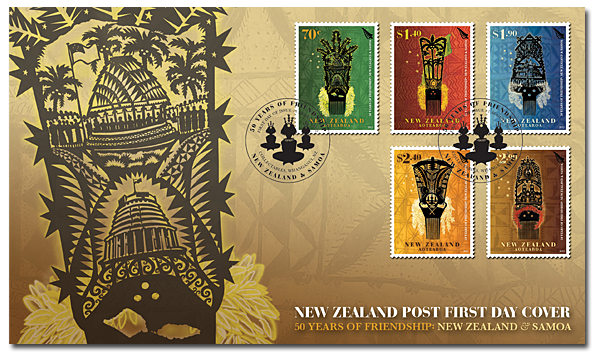New Zealand and Samoa share a special relationship that is underpinned by the 1962 Treaty of Friendship. 2012 marks 50 years of this important partnership, and New Zealand Post celebrated this with very a unique stamp issue. At about the same time these stamps were issued Samoa celebrated 50 years of independence. The stamps issued by Samoa to mark this event can also be seen at the bottom of this post.
An interesting set of five stamps that stand out as being very different to stamps usually issued by New Zealand. Each of the five stamps features a contemporary view of a selu tuiga – a head comb that takes the shape of a traditional tuiga. A tuiga is a Samoan headdress that is worn at important events by the mānaia (son) or the taupou (daughter) of the high chief of the village. The tuiga is a unique symbol of the chiefly nature of Samoan society, and a significant number of tuiga were worn when Samoa gained independence.
The Stamp Designs.
Michel Tuffery lives and works in Wellington, New Zealand (Aotearoa), and is a famous multi-disciplinary artist of Samoan, Rarotongan and Tahitian heritage. Tuffery has established himself as a diverse and critical creative practitioner within contemporary New Zealand and Pacific Island art, and his work features in major public and private collections globally.
70c - Fu'a
Fu’a is the Samoan word for flag and the fu’a of independence flies in front of the original Samoan Maota Fono or Parliament House. This Maota Fono was built in the shape of a circular Samoan meeting house. Chiefs and orators have discussed issues in a circular manner since time immemorial – making the form of the circle a traditional and sacred symbol.
$1.40 Niu
The coconut tree or niu is a very important tree for sustenance. For thousands of years, the lives of the Samoan people depended on this tree of life. It provided food, milk and oil as well as shelter, baskets and other woven artefacts used by Samoans in their everyday lives.
$1.90 - Maota
The Maota Fa’amasino or the Courthouse building is 110 years old, and one of the oldest buildings in the city of Apia. The building was built by the Germans in 1902 and has seen two foreign administrations (Germany and New Zealand) occupy it, before Samoans took over after gaining independence from New Zealand.
$2.40 - Tatau
Traditional Samoan tatau (tattoo) motifs and patterns are taken from nature. There are the tulī (godwit) bird, the centipede, the trochus shell and the ‘aso, the rafters of a fale on to which thatches are lashed, and a number of other shapes including a va’a (twohulled canoe) that sits at the top on the back of a male tatau.
$2.90 Malumalu
Malumalu o le Atua means ‘church building’ and the Catholic Church’s Immaculate Conception of Mary Cathedral at Mulivai was a symbol of spiritual sustenance that graced the shoreline of Apia Harbour. Sadly, the Cathedral was demolished after 127 years, when the 8.1-magnitude earthquake of September 2009 shook it to an irreparable state.
Miniature Sheet & First Day Cover.
Of course the usual collector items were released as well. Here again the designs stand out against other New Zealand stamp.
50 Years of Samoan Independence.
I therefore decided to include them here.
$1 - Fautasi racing
Samoan multi-oared whaleboats, traditionally used for travel between islands.
$2 - Coastal Scene
Palm trees, blue ocean, what we all imagine Pacific Islands to be.
$3 - Singing and Dancing.
Samoan Independence Day is always celebrated with lots of singing, dancing and feasting.
$3 - Singing and Dancing.
Singing and dancing on Independence Day.
When I discovered this miniature sheet, I just had to include it on this page.
Technical information:
Date of issue:
| 1 August 2012 |
|---|---|
Number of stamps:
| Five gummed stamps |
Designed by:
| Michel Tuffery MNZM, Wellington, New Zealand |
Denominations:
| 70c, $1.40, $1.90, $2.40 and $2.90 |
Printer and process:
| Southern Colour Print Ltd by offset lithography |
Number of colours:
| Four process colours |
Stamp size and format:
| 30mm x 40mm (vertical) |
Paper type:
| Tullis Russell 104gsm red phosphor gummed stamp paper |
Number ofstamps
| 25 |
Perforation gauge:
| 14 x 14 |
Period of sale:
| Unless stocks are exhausted earlier, these stamps will remain on sale until 31 July 2013 |
Some of the images in this post were used with permission from the illustrated catalogue of StampsNZ
You can visit their web site and On-line Catalogue at, http://stampsnz.com/













We appreciate your engagement with our content. To ensure a respectful and constructive community, please take note of the following:
- No Spam, Please: We do not tolerate spammy or promotional comments. Any such comments will be promptly removed.
- Moderation in Place: All comments are moderated to maintain a positive and inclusive environment. Please be patient, as it may take a little time for your comment to appear.
- Sign In with Google: To comment, please sign in using your Google account. This helps us maintain the integrity of our community and allows for better interaction.